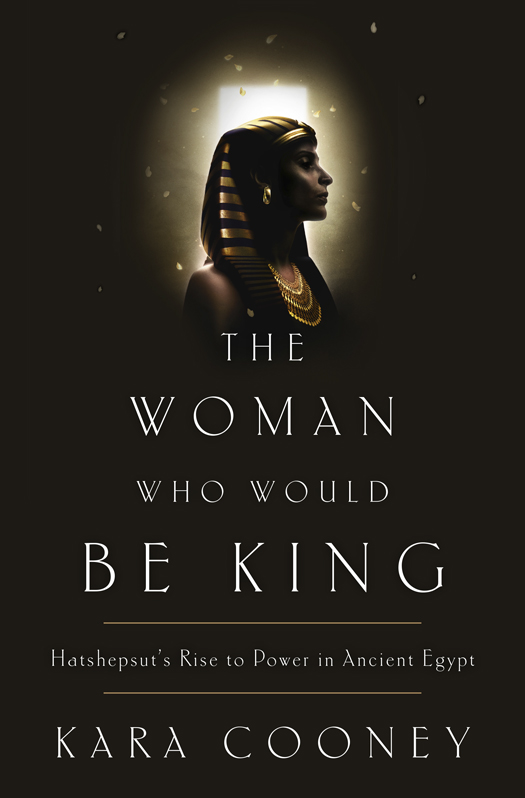
The Woman Who Would Be King
Hatshepsut's Rise to Power in Ancient Egypt
کتاب های مرتبط
- اطلاعات
- نقد و بررسی
- دیدگاه کاربران
نقد و بررسی

August 4, 2014
The life of Hatshepsut, Egypt’s second female pharaoh, was replete with opulent living, complex royal bloodlines, and sexual energy; in short, the kind of drama that fuels Ancient Egypt’s enduring appeal. What it lacked, however, was comprehensive documentation—something UCLA Egyptologist Cooney offers in a narrative biography supplemented by scholarly hypotheses that attempt to flesh out the uncertainties. Groomed for an important role as a high priestess from birth, Hatshepsut, through a combination of good fortune and ruthless strategy, “scaled the mountain to kingship.” Her role ostensibly “decreed by nothing less than a divine revelation” is shrouded in mystery by a limited historical record concerned too frequently with the “supernatural mechanisms of divine authority.” The high points; of this ambitious project are to be found in Cooney’s keen sense for the visual elements of Hatshepsut’s gender-defying rule and expert inferences on the psychologies of Hatshepsut and her contemporaries. From Hatshepsut’s self-perception, political prowess, and lifestyle emerge an image of the “ultimate working mother” and a compelling insight into ancient gender roles. However, Cooney’s work will likely appeal most to already well-informed armchair Egyptologists, as unfamiliar nomenclature and the speculative tone can make this a difficult text for the casual reader. Agent: Marc Gerald.

August 15, 2014
Cooney (Egyptian Art and Architecture/UCLA) re-creates the life of "the first woman to exercise long-term rule over Egypt as a king."The author endeavors to discover why history rejected Hatshepsut's remarkable achievements. Twenty-five years after her death, her surviving co-king decided to obliterate her image and name from carvings throughout the land. As Cooney admits, this biography could only be based on conjecture and guesswork, but the addition of expertise makes it well worth reading. The author's Egyptology background provides the nitty-gritty of daily life and animates this king (at the time, there was no word for "queen"). The surviving buildings and carvings of Hatshepsut's 22-year reign serve as evidence of her accomplishments. Upon the death of her father, Thutmose, Hatshepsut was married, as was customary, to her brother, the short-lived Thutmose II. She was already Egypt's high priestess, and she now became the King's Great Wife. Widowed after a few years, she became regent for the infant Thutmose III, making her the most powerful person in Egypt. Eventually, she had herself crowned king and reigned with him until her death. How she gathered and maintained her power is simple enough: money. It was a period of strong trade, uninterrupted annual inundation of the Nile River and successful empire building. Hatshepsut professionalized the priesthood and the army, and she spent fortunes expanding the empire and quickly rewarding those who served her. Furthermore, as high priestess, it was she who delivered Amun-Re's rules and decisions. The image of this woman became increasingly masculinized as her reign progressed, reflecting the age-old distrust of a woman with authority. Of course, there are still questions ("Certainty plays little role in the history of Hatshepsut"), but Cooney's detective work finally brings out the story of a great woman's reign.
COPYRIGHT(2014) Kirkus Reviews, ALL RIGHTS RESERVED.

Starred review from October 15, 2014
Despite reigning for more than 20 years, creating a stable and prosperous country, and sending expeditions to unchartered lands, King Hatshepsut, the fifth pharaoh of the 18th Egyptian dynasty of ancient Egypt, has largely been forgotten in history and often even marginalized by scholars who vilified her for doing something unconventional, though it was in line with ancient traditions. Cooney (Egyptian art and architecture, Univ. of California, Los Angeles) takes a different approach in her search for the real Hatshepsut, the woman who garnered the political and religious power to become a king. The author draws on two decades of experience studying ancient Egypt and adds her own deductions and speculations (and sometimes multiple deductions as to what might have happened when the historical and archaeological record is mute) to create a realistic character profile. Complementing the text are extensive notes, architectural drawings, an index, and further reading. VERDICT Cooney does a fantastic job of breathing new life into her subject and showing the woman who dared to keep herself and her nephew Thutmose III on the throne, as well as what led Hatshepsut's name to be tarnished and nearly erased from history. The book will be of great interest to those fascinated by ancient Egypt, history, and women's history. [See Prepub Alert, 5/4/14.]--Melissa Aho, Univ. of Minnesota Bio-Medical Lib., Minneapolis
Copyright 2014 Library Journal, LLC Used with permission.

September 15, 2014
Egyptologist Cooney peels back the layers of the life of Hatshepsut, Egypt's second female pharaoh, providing a multidimensional portrait of a woman of strength, intelligence, and substance. Less well known than Cleopatra, she was, according to the author, a more powerful and influential leader than the Queen of the Nile. Because she virtually disappeared from history for many centuries after some of the records of her achievements and many of her monuments were destroyed, her wily ascension to the throne and her subsequent reign have been largely obscured and overlooked by scholars. Cooney rectifies this oversight with this in-depth though often speculative peek into the political and psychological strategy of a woman who essentially catapulted herself onto the throne. By examining her subject within the context of the stringent gender restrictions of her time and place, she attempts to explain the motivations and the thought processes of one of the most successful female leaders of the ancient world.(Reprinted with permission of Booklist, copyright 2014, American Library Association.)

























دیدگاه کاربران